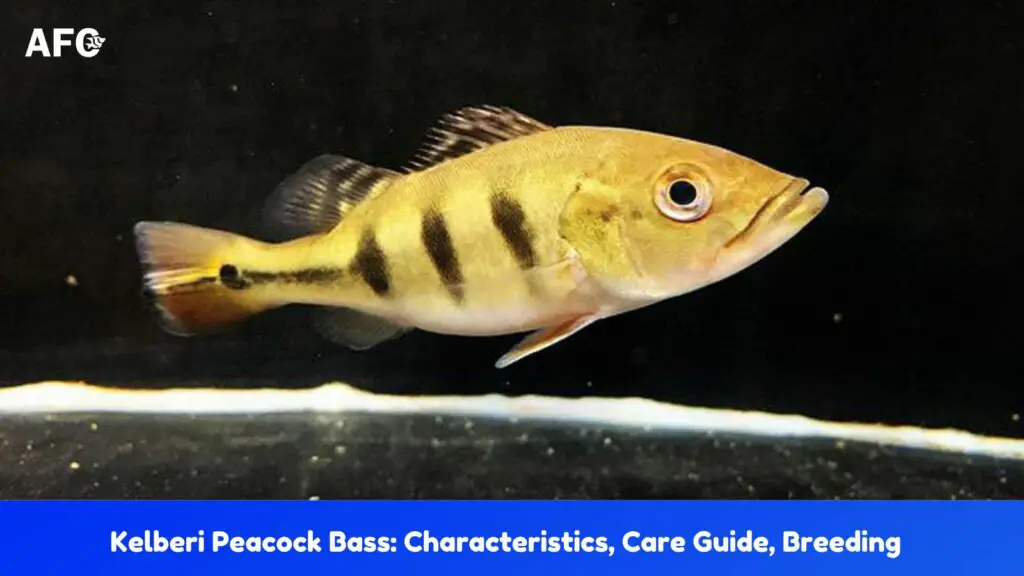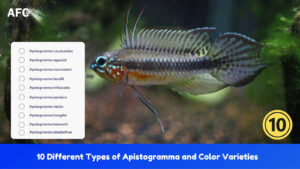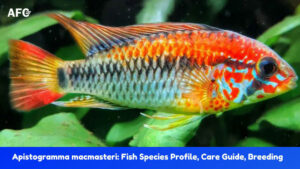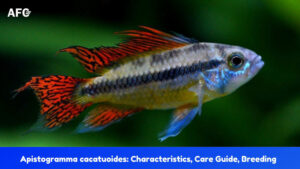The Kelberi Peacock Bass (Cichla kelberi) is a diurnal freshwater cichlid species belonging to the genus Cichla. This predatory South American fish has gained popularity in recent years within the aquarium hobby due to its yellow-golden coloration and manageable adult size compared to other peacock bass species.
The well-known types of Kelberi Peacock Bass include the naturally occurring forms “Bahia” and “Ceara,” as well as the man-made morph “Spider” developed through selective breeding.
Because of their large size, fast growth rate, and strong predatory instinct, not everyone can meet their care and breeding (spawning) requirements in captivity.
Read on and learn the Kelberi Peacock Bass species profile and what it takes to care for and breed this very energetic predatory cichlid in your aquarium.
What Are Kelberi Peacock Bass?
The official scientific name of the Kelberi Peacock Bass is Cichla kelberi. It is named for Brazilian peacock bass expert Dieter Kelber, who promoted Cichla species as sport fish and supported studies of the C. kelberi and C. piquiti with information and images. In Brazil, it is commonly known as the Tucunaré amarelo.
According to a 2006 study titled “A review of the South American cichlid genus Cichla, with descriptions of nine new species (Teleostei: Cichlidae)” by Sven O. Kullander and Efrem J. G. Ferreira, C. kelberi is distinguished from other Cichla members by the presence of small light spots on the pelvic, anal, and lower lobe of the caudal fin in adults.
In comparison to its most similar relatives, C. pleiozona and C. monoculus, C. kelberi does not develop the black markings laterally on the head. Furthermore, a subtler difference between C. kelberi and C. pleiozona is the number of scales in their lateral line: C. kelberi has 76 – 83 scales, while C. pleiozona has 84 – 93 scales.
Although C. kelberi is not the smallest Cichla species in the wild, its brightest golden color makes it the most attractive of all species in this group in the aquarium hobby.
What Are The Most Common Types of Kelberi Peacock Bass?
The most common types of Kelberi Peacock Bass are listed below.
- Bahia Kelberi Peacock Bass (Cichla kelberi ‘Bahia’)
- 24K Kelberi Peacock Bass (Cichla kelberi ‘Ceara’)
- Spider Kelberi Peacock Bass (Cichla kelberi ‘Spider’)
Bahia Kelberi Peacock Bass (Cichla kelberi ‘Bahia’)
The Bahia Kelberi Peacock Bass is a wild form of Cichla kelberi that was mainly collected from the Araguaia River drainage basin near the Bahia state of Brazil. The majority of specimens sold in the trade are first-generation (F1) fish bred from wild-caught parents that were from this region.
24K Kelberi Peacock Bass (Cichla kelberi ‘Ceara’)
The 24K Kelberi Peacock Bass, also sold as “Gold/Golden” Kelberi Peacock Bass, is a geographic variant of Cichla kelberi that hails from the lower Tocantins River drainage basin near the Ceara state of Brazil. The 24K variety is known for its intense yellow-gold coloration than Bahia specimens.
Spider Kelberi Peacock Bass (Cichla kelberi ‘Spider’)
The Spider Kelberi Peacock Bass is a highly sought-after color mutation created through selective breeding in Asia. This variation has an extremely intense yellow-gold sheen with intricate black stripes and spots, resembling the look of a spider web.
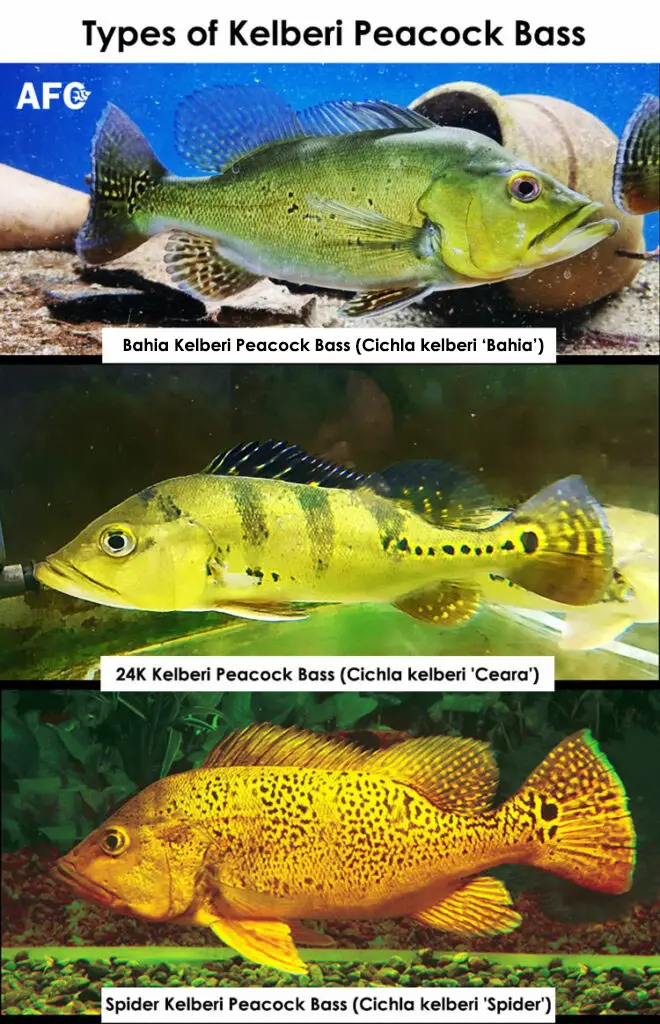
How Big Do Kelberi Peacock Bass Get?
Kelberi peacock bass typically grow to 10-12 inches (25-30 cm) long in the aquarium environment. However, some individuals can reach a maximum size of around 18 inches (45.7 cm). This is pretty reasonable compared to many other peacock bass species that grow up to 28 inches (71 cm) in length.
Kelberi peacock bass are fast growers. They can grow up to 1-1½ inches (2.5 – 3.8 cm) per month under ideal conditions, reaching their full size in 6-8 months. To increase their growth rate, do not feed them pelleted foods until they are at least 6 inches (15 cm) long.
Are Kelberi Peacock Bass Aggressive?
Yes, Kelberi Peacock Bass are considered to be aggressive fish. They are predatory by nature and will view any aquatic creature that can fit in their mouth as prey. They are also territorial and behave aggressively toward other fish in the tank.
How to Tell a Male From a Female Kelberi Peacock Bass?
The positive way to determine the sex of a mature Kelberi Peacock Bass is by examination of the genital papilla (or vent), which is a small slit-like protrusion located between the anal and ventral fins. Males have pointed V-shaped genitalia, while females have larger, rounded U-shaped genitalia. This method requires some experience to get it right and should only be attempted on larger fish (6-7 inches or more).
Many owners suggest looking for the nuchal hump, a raised area of flesh on the forehead of adult males, as an indication of the fish’s sex. However, this method is not reliable since some females can also show a nuchal hump during the breeding season.
How Long Do Kelberi Peacock Bass Live?
Kelberi Peacock Bass can live for up to 15 years in captivity when kept in optimal environments with adequate space, clean water, and a balanced diet.
What is the Native Habitat of Kelberi Peacock Bass?
The Kelberi peacock bass is endemic to the Araguaia River and lower Tocantins River drainages in Brazil. These fish are found in slow-moving rivers lined with dense vegetation. Like other peacock bass, they are diurnal, meaning they are primarily active during the day and rest at night.
How to Take Care of Kelberi Peacock Bass?
To properly set up an aquarium and care for Kelberi Peacock Bass, the following are the requirements that all responsible fish owners need to provide.
- Provide a spacious tank
- Maintain optimal water parameters
- Decorated the aquarium with driftwood
- Feed them a balanced and varied diet
- Choose compatible tank mates
Provide a Spacious Fish Tank for Kelberi Peacock Bass
Kelberi Peacock Bass are active, large, and fierce predators that thrive in a spacious aquarium. The minimum tank size for a single Kelberi Peacock Bass is 180 gallons (72″ x 24″ x 24″), and larger aquariums are always preferred. This is because Kelberi Peacock Bass are fast swimmers and love to have plenty of room to swim around. Additionally, a larger tank will help to reduce the chance of them hitting the glass while chasing food.
Remember, these fish can grow to their full size in 6 – 8 months. It’s best to house them in a larger tank right from the get-go.
Use A Quality Filtration System
Native to tropical warm waters with higher dissolved oxygen (DO) concentrations. Plus, Kelberi Peacock Bass produce a substantial amount of waste, so it is important to have robust and powerful canister filters or a sump filter in place to keep the water clean and healthy.
As for water parameters, Kelberi Peacock Bass are pretty hardy and can handle a wide range of water parameters, especially captive-bred specimens. To ensure crystal clear water, try to match the water conditions of your tank to their native habitat as closely as possible.
The ideal water parameters for Kelberi Peacock Bass are as follows.
- Temperature: 76ºF – 84ºF (24ºC – 29ºC)
- pH: 6.0 – 7.5
- KH: 5-15
Check your water chemistry regularly to ensure the levels are within these parameters.
Decorate the Aquarium with Large Driftwood
Include pieces of large driftwood or bogwood with arches to round out the decor. This not only helps to keep the water pH softer and more acidic but is also a good means of giving them places to hide behind. Large rocks can be added for additional hiding spots. Be sure to leave plenty of open swimming space in the middle.
Feed them a Balanced and Varied Diet
In the wild, Kelberi Peacock Bass are predatory fish that primarily or exclusively feed on a wide variety of live foods, such as smaller fish, worms, insects, amphibians, and crustaceans, hence the challenge of weaning them onto pelleted or frozen foods in captivity.
In the aquarium, here is a step-by-step guide on how to convert Kelberi peacock bass off live food.
- Start by feeding your fish one feeder at a time. Do not drop all feeders into the tank at once. To start, get their attention by moving your hand just above the water’s surface with one feeder fish. When the fish comes up to take it, quickly drop it in the water, and wait until the fish is finished eating before offering the next one. Do this for a week or so until they come to the surface and await you to drop off the feeder. They should be hitting the feeders with natural instinct by this point.
- Once the Kelberis are consistently hitting the feeders, start introducing freeze-dried krill. After about two feeders, drop a krill in the tank. They may take a minute to figure out what it is and spit it out, but keep trying. Eventually, they will start eating the krill.
- Continue alternating between feeders and krill until the bass Kelberis consistently accept the krill. Once they are, you can start reducing the number of feeders you give them.
- You can also try other foods like frozen mysid shrimp or bloodworms. Experiment to see what they prefer.
- Give the Kelberis some live food to keep them interested every so often. This will help to prevent them from becoming picky eaters.
Here are some additional tips:
- Don’t start too early. Wait until the Kelberis are at least 6-7 inches long before trying to convert them to non-live food.
- Make sure the feeder fish are healthy. You don’t want to introduce any sickness into the tank.
- Don’t overfeed! Too much food can lead to health issues, such as fatty liver disease and bloat.
- Be patient. It may take some time for the Kelberis to adjust to the new food.
Tank-raised fish are normally trained to accept frozen food at an early age, so if you’re buying from a reputable breeder, the weaning process should be much easier.
Choose Compatible Tank Mates for Kelberi Peacock Bass
Similar to other predatory South or Central American Cichlids, Kelberi Peacock Bass have a reputation for being ornery and will badly injure tank mates that can’t defend themselves.
For the best success, choose tankmates that are as big or bigger than the Kelberis and have a similarly aggressive temperament.
Some compatible tankmates for Kelberi Peacock Bass include the following.
- Other Cichla species
- Arowana
- Red terror cichlid (RTC)
- Tiger shovelnose catfish (TSC)
- Silver dollars
- Tinfoil barbs
- Royal clown knifefish
- Freshwater stingray
It’s important to consider the rapid growth rate of Kelberi Peacock Bass when selecting compatible tank mates.
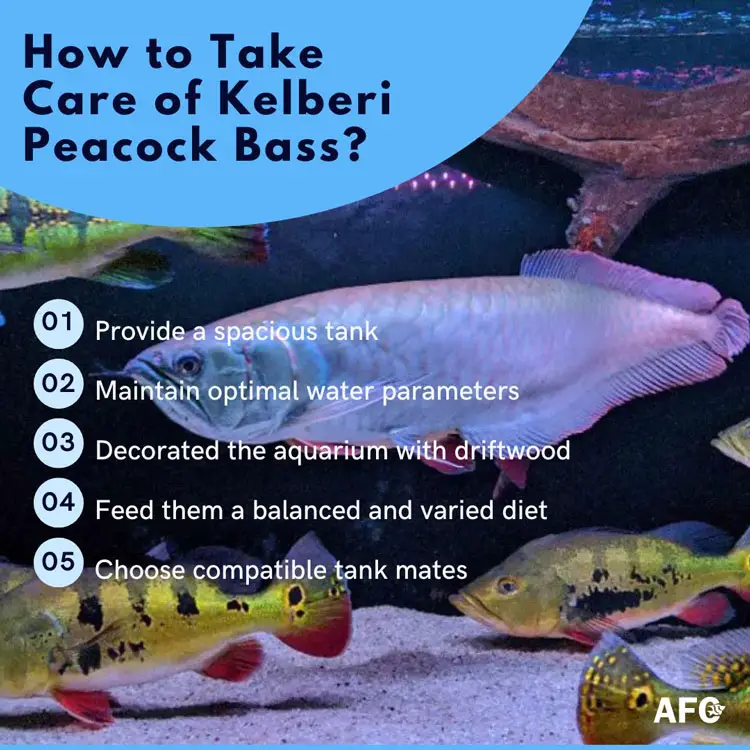
How to Breed Kelberi Peacock Bass in Home Aquariums?
The following is a basic overview of the breeding process of Breed Kelberi Peacock Bass.
- Get Your Breeding Pair/Trio. The best way to obtain breeding Kelberi Peacock Bass is to buy a batch of 6 or more juveniles and let the fish pair off on their own. It can be difficult to find a breeding pair in the trade. As the fish grow, weed out those that don’t have the desired coloration, sex them, and cull the pair.
- Prepare the Breeding Tank. Set up a dedicated breeding tank of at least 240 gallons with a bare bottom. Provide a large slate rock for them as a spawning site. Keep the pair alone if you are serious about breeding them. Perform water changes of 50-60% weekly.
- Condition the Breeding Pair. They will clean the spawning site. If you have sand or gravel substrate, you will note the pair dig a hole where they’ll care for the eventual fry. Condition them with feeder fish or other food with a high protein content as much as they will consume once they show the spawning behavior.
- Stimulate Spawning. When your breeding pair is ready, do a 30% water change daily for 3 days. On the fourth day, do a larger water change to drop the temperature by about two degrees. In most cases, this should encourage the pair to spawn on the same day.
- Remove the Eggs. To make it easy to take care of the fry, remove the eggs from the tank and place them in a separate 20-gallon tank with nothing but a sponge filter. The female will lay 2,000 to 3,000 eggs, but only 5-10% of eggs will hatch in approximately 60 hours once laid, mostly because the male failed to fertilize them properly. The unfertilized eggs are bright white or yellow in color and may develop fungus. Adding a few drops of methylene blue to the water helps prevent fungal growth.
- Fry Care and Feeding. The fry will be free swimming by day 7 or 10. During this time, they absorb their egg yolk sac for nutrition and don’t need to be fed. Feed them freshly hatched brine shrimp once they become free swimming. More importantly, make frequent water changes of 15 to 20 percent daily to ensure good water quality.
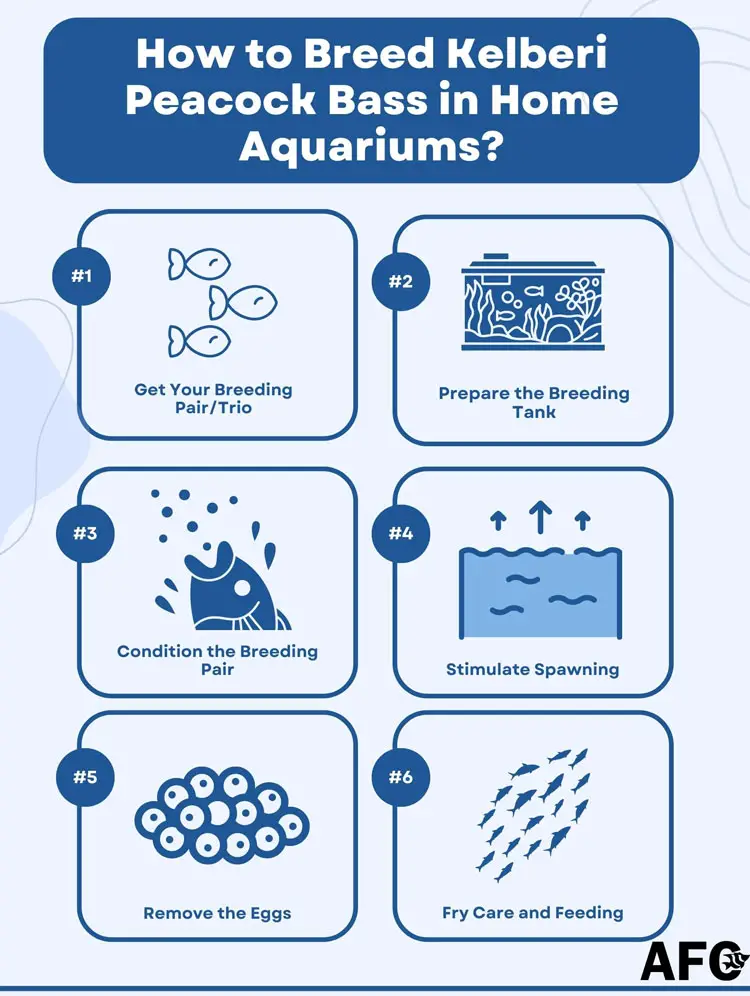
What South American Cichlids Look Like a Kelberi Peacock Bass?
The South American cichlids that look the most like a Kelberi Peacock Bass include the following.
- Lake Gatun peacock bass (C. pleiozona)
- Monoculus peacock bass (C. monoculus)
- Orinoco peacock bass (C. orinocensis)
- Jari peacock bass (C. jariina)
- Xingu peacock (C. mirianiae)
- Yellowhump Eartheater (Geophagus pellegrini)
